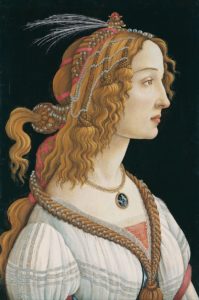Top 10 Facts about the Birth of Venus from Botticelli
Sandro Botticelli created the Birth of Venus at a time when Christian and particularly the Catholic faith was winding down and Greek mythology took over as the inspiration. The Birth of Venus is a large canvas, sensual in nature that Botticelli completed in 1486.
For a controversial piece of art during its time, The Birth of Venus does not hide at all! It measures about 6 feet by 9 feet, earning the title “first large-scale canvas created in Renaissance Florence.” There is a lot to discover about this renowned painting that the top 10 facts about The Birth of Venus by Botticelli will show.
1. The Birth of Venus from Botticelli is one of the first works on canvas to gain recognition
The Birth of Venus was painted during the Early Renaissance period when most artists painted on wood panels for its affordability and durability. Wood however would sometimes warp, and some artists then opted for canvas, especially in humid areas. The downside to canvas was its status. Canvas was ranked lower since it was cheaper than wood, and artworks painted on them were not particularly intended for major public viewing.
Botticelli painted the Birth of Venus on canvas- contrary to the norm, this piece stood out gaining recognition as a fifteenth-century Italian painting, in spite of the ‘dreadful’ canvas.
2. The nudity displayed in The Birth of Venus was unusual at the time
Rather daring, Botticelli produced a nude painting at a time when Christianity was the main influence and inspiration. Nudity was definitely out of the question, much less if frozen in time for all and sundry to see!
Nude artwork however started making a comeback when humanism emerged and with it an attention to the myths of ancient Rome which included nude art forms.
3. The Birth of Venus is a display of gods
The main subject in Botticelli is Venus, the goddess of love, standing demurely on a seashell. Zephyr the god of the west wind is seen blowing her ashore while carrying either Aura or Chloris, nymphs of the wind and spring, and blossoming flowers respectively.
As Venus is blown ashore, Horae, goddess of the seasons is on standby with a cape to cover the newborn god Venus. She’s seen holding the cape out.
The Birth of Venus is quite the authoritative painting, all gods therein considered.
4. The Birth of Venus has a twin painting
While the Birth of Venus shows Venus arriving on earth, another of Botticelli’s works, La Primavera shows a world in bloom around a clothed Venus. These two paintings put side by side tell a story.
The irony however is that La Primavera was painted after The Birth of Venus! It should have been the other way around if the story told by the two paintings was to be followed sequentially. The two paintings were created to tell a story of how love triumphs over brutality.
5. The Birth of Venus was at risk of obscurity
Most grand artworks are protected with a coat of varnish to ensure that the painting’s integrity is upheld. In the case of The Birth of Venus, this protection almost turned lethal- the coat of varnish literally started turning opaque obscuring the paintings details.
Thanks to cautious restoration work carried out, the Birth of Venus was saved and was perfect for viewing by 1987. The soft pearly colors Botticelli had used were revealed once more, and even better as some costly alabaster powder was used which brightened the colors and made them timeless.
6. The Birth of Venus may have been created as a replacement
The masterpiece Venus Anadyomenes is a C. 1520 painting by Titian in which the goddess Venus is seen rising from the sea and wringing her hair, after her birth fully-grown. Titian’s work was said to be an imitation of Apelles painting which got lost.
There are a number of similarities between Apelle’s lost work and Botticelli’s Venus. It’s believed that Botticelli’s work was Apelles replacement.
7. The birth of Venus epitomizes beauty
The Birth of Venus has been used as a yardstick for the beauty of other eras, and a tool to criticize modern beauty standards. Modern-day models such as Holly Hagan and Heather Byrd have recreated Venus’ iconic pose in photo shoots. Iconic musician Lady Gaga recreated Venus in some of her music.
Botticelli’s iconic painting was also subjected to modern-day photo treatments that are meant to enhance photos- the results were not as impressive. Imagine Venus duck- lipped and pouting, with exaggeratedly enhanced body features. Venus was experimentally photoshopped in 2014 to ‘fit in’ with modern beauty standards, but the results were unimpressive. The original painting was much better.
8. Simonetta Cattaneo de Vespucci was the muse in The Birth of Venus
She was an Italian married noblewoman whom Botticelli carried the flame for but his was an unrequited love. Simonetta Cattaneo de Vespucci is said to be Botticelli’s muse in other paintings besides The Birth of Venus. She was said to be the most beautiful woman in Italy.
One of Botticelli’s dying wishes was to be buried at the feet of his Venus, Simonetta. At his death in 1510, his wish was granted as he was buried near Simonetta.
9. The Birth of Venus was hidden from view for about 50 years!
The Birth of Venus wasn’t meant for the public eye. It was a daring piece of art especially given the period during which it was created. When one considers the fact that the painting was meant to overlook a marital bed, the nudity on display becomes that much more sensual.
The small detail included, where the meadow that the subjects of the painting are in is sprinkled with violets, which were a symbol of modesty but often used for love potions is also telling of the essence of the painting. For these reasons, The Birth of Venus was kept hidden from view for around 50 years.
10. The Birth of Venus was spared from being torched
When the ‘Bonfire of the Vanities’ was lit in 1497, mirrors, artworks, jewelry, dice, rings and any other items believed to promote sin were tossed into a seven-story furnace and destroyed. This was a purge instigated by Dominican friar Girolamo Savonarola and championed by Christians.
While the Birth of Venus from Botticelli out rightly falls in the category of the purge items for its nudity, it was spared. Perhaps Botticelli, who was amongst the Christians purging and even tossed some of his items into the furnace found it too grand to just burn?
The Birth of Venus is a beloved example of Renaissance art. It continues to be influential and puts to shame the sometimes ridiculous beauty standards society enforces on women. Botticelli did not live long enough to see the success of his work as they were overshadowed by High Renaissance artists. However, his works, including The Birth of Venus earned the fame they deserved in the 19th century.
The Birth of Venus was Botticelli’s most respected work of art. You can see it at the Uffizi Gallery in Florence, Italy.
Planning a trip to Paris ? Get ready !
These are Amazon’s best-selling travel products that you may need for coming to Paris.
Bookstore
- The best travel book : Rick Steves – Paris 2023 – Learn more here
- Fodor’s Paris 2024 – Learn more here
Travel Gear
- Venture Pal Lightweight Backpack – Learn more here
- Samsonite Winfield 2 28″ Luggage – Learn more here
- Swig Savvy’s Stainless Steel Insulated Water Bottle – Learn more here
Check Amazon’s best-seller list for the most popular travel accessories. We sometimes read this list just to find out what new travel products people are buying.


















